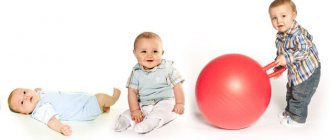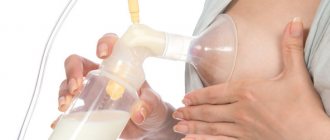Having become a mother, every woman dreams of breastfeeding her baby. But it often happens that due to certain factors, breastfeeding is not possible. This can happen for two reasons:
- the baby does not latch on to the breast;
- there is no breast milk or there is not enough milk for the baby.
In both cases, a baby bottle with a nipple comes to the rescue. The solution to the first problem is to frequently express and bottle-feed the baby, or completely switch to artificial feeding.
The second problem is no more difficult - baby food manufacturers solved it long ago. Nowadays the baby formula market offers a huge selection of breast milk substitutes, enriched with vitamins and minerals for proper nutrition and development of the child.
Having solved the problem with “food”, new mothers are concerned about how to properly feed the newborn and how many times the baby should eat.
When do you need a bottle?
If the baby is mixed-fed, pediatricians do not recommend using a bottle. The fact is that the baby quickly gets used to the comfortable nipple and no longer wants to return to breastfeeding. In this case, a spoon is used for a baby, a syringe for a newborn, and a mug for older children. Note that today they are releasing a special system with a tube, which is as close as possible to natural feeding. By the way, when supplementary feeding, they first breastfeed and then supplement the baby. If the baby is completely bottle-fed and there are no plans to return to breast milk, then take a bottle. Be careful when choosing a product. It should be high-quality and safe for newborns. Glass bottles are easy to wash and sterilize. They will withstand repeated boiling and last longer. However, glass containers break easily. Plastic bottles are safe and convenient for an infant, if, of course, they are made of high-quality food-grade plastic. However, such products will have to be changed more often, since they quickly lose their shape after boiling.
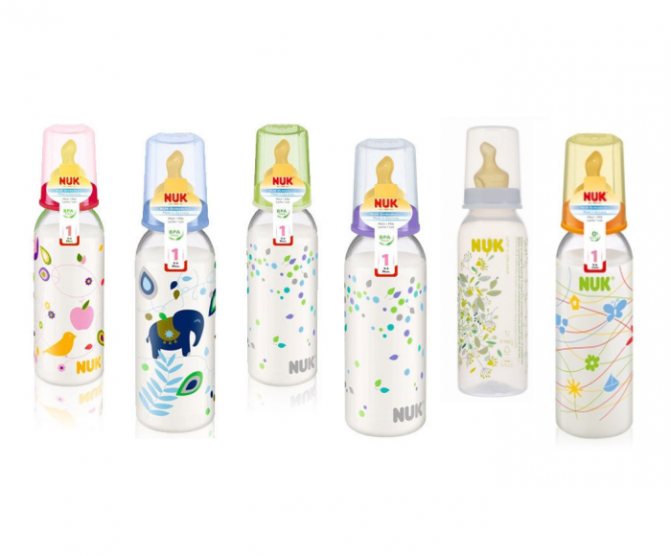
Read more about how to choose the right feeding bottle here. Regardless of the choice, the container must be clean and sterilized. The product should not have cracks or stains. The pacifier should also be clean and intact!
Preparing for feeding
It is important that you have bottles and nipples ready for the new feeding. They must be thoroughly washed and sterilized. Before feeding your baby, wash your hands thoroughly with soap and then prepare the formula. To prepare the mixture, it is important to follow the instructions on the package. If you add more water, the baby will not receive the required dose of vitamins, and if less, the child may become dehydrated! Before each feeding, it is advisable to prepare a new mixture. In exceptional cases, the product can be stored in the refrigerator for up to 24 hours. If you are feeding a pre-prepared formula, then heat the milk in a water bath or simply in hot water.
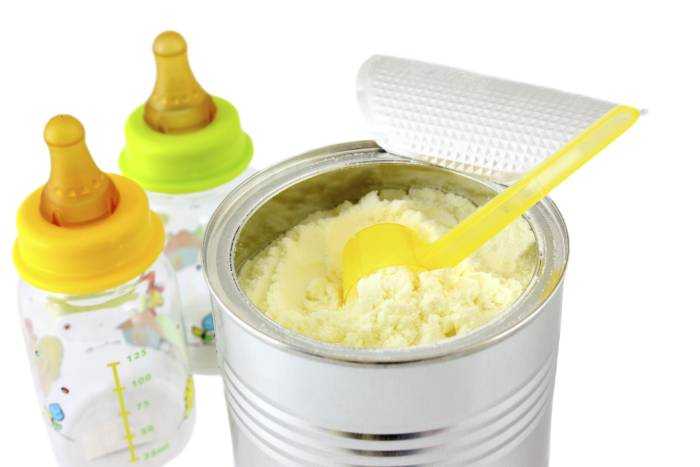
The mixture should be diluted with water at a temperature of 36-37 degrees. For breeding, use special baby water or regular boiled water. Be sure to check the food temperature before feeding! If you don't have a thermometer, place a drop of the mixture on your wrist. You can put a bib on your baby to prevent it from getting dirty. And put a towel on yourself or put on clothes that you don’t mind. Remember that the baby will spit up when feeding. Before feeding your baby, check whether the milk flows normally from the bottle. When tilted, it should flow out in drops. Before each feeding, place your newborn's tummy on a hard surface for a few seconds. When feeding, it is important to establish an emotional connection with the baby so that the procedure is comfortable and calm. You should not feed your baby if he is irritated or upset. You should not give the mixture to a baby if he cries a lot and resists. Try to calm him down. You cannot force feed a newborn! Wait until he gets hungry.
Baby feeding positions
Let's consider in what position and position to feed the baby, as well as how to hold the baby correctly when feeding. There are several basic positions for children during artificial feeding - lying down, on their hands, on their side, sitting.
Any position should be comfortable for both the baby and the parent.
So that he doesn't burp
Poses to prevent regurgitation:
- In this case, the child is positioned on his side. It is better if it is the left side, as pediatricians recommend.
- You can fix its position with special clamps, feeding rollers or a pillow.
- Mom gives him a bottle from the side, and she can also lie on her side to maintain eye contact with the baby.
- Be sure to monitor the filling of the nipple with milk during the process.
So that he doesn't choke
- Mom sits on the sofa or a comfortable chair, leaning her back on it.
- Bends his knees and positions the child so that his butt sits on one hip and his back lies on the other.
- The head must be placed on the elbow.
- With her free hand, mom is holding a bottle of milk.
It is necessary to check the flow rate , which depends on the number of holes in the nipple and the angle of inclination of the bottle itself.
So as not to choke
- The baby lies in his crib, and his mother sits next to him.
- When feeding in this case, you can put a flat diaper, the thinnest pillow or towel.
- The bottle is positioned at an angle of 45 degrees. This position creates optimal milk flow rate and comfort.
In this case, it is not recommended for mom to stand, because your back will take an unnatural position and just start to hurt. It is important to control the tilt of the head , because... It is its incorrect position that causes milk to enter the respiratory tract.
To prevent air from getting in
The entry of air along with food leads to a false feeling of fullness in the brain. Be sure to take breaks during bottle feeding and calmly remove it every 5-10 minutes for a few seconds so that he can burp.
But in order to minimize the amount of air entering, it is necessary to feed him in a semi-upright position. This pose is the most common.
- Mom takes the child in her arms.
- His head is conveniently located on the bend of his elbow, his palm holds his butt.
- With her free hand, the mother gives him the bottle at an angle so that the entire cavity of the nipple is filled with milk.
It is necessary to check for bubbles in the mixture and, if they appear, change the baby’s position to vertical, removing the bottle from his mouth.
Lying down
Is it possible to feed a newborn lying down? Experts do not recommend giving a bottle in this position due to the risk of milk drops getting into the middle ear and causing an infection.
If the child lies flat, but on a slight slope, then the risk of middle ear disease is minimal.
Other provisions
If the baby is already sitting confidently, then he, showing independence, can hold the bottle himself and choose a position that is comfortable for him, as well as eat while sitting. In such cases, the parent also needs to be nearby and supervise the feeding process.
Bottle feeding technique
- When feeding, the bottle should be held at a slight angle so that the nipple is filled with milk;
- Make sure that the milk completely fills the nipple;
- You cannot hold the bottle vertically, otherwise the baby may choke!;
- The nipple ring should not fit too tightly to the container. If a little air gets into the bottle, the nipple will not flatten. But too much air should not get in there either!;
- When feeding, the baby's head should be slightly raised and not tilt back or to the side. Do not hold your newborn in a horizontal position!;
- Take breaks during feeding to allow your baby to burp. At this time, you need to hold the child in a straight or semi-upright position for several seconds;
- If you feed your newborn correctly, bubbles will appear in the formula bottle;
- Don't leave your newborn alone with a bottle!
Comfortable positions for bottle feeding
It is very important to keep the baby in the correct position so that he does not accidentally choke, burp, or experience colic or flatulence. Feeding a baby from a bottle can occur in several positions:
- To prevent regurgitation. The baby is placed on his left side, the position is correctly fixed with a pillow or bolster. The bottle is served from the side, constantly monitoring the filling of the nipple.
- To prevent the newborn from choking. Mom sits down comfortably, resting her back against the back of a chair or sofa. The baby sits on his mother’s lap, with his butt on one hip and his back on the other. The head should be on the bend of the elbow.
- Using a special pillow. The baby is placed on the pillow at the optimal angle, in the desired position. It is important to constantly monitor the feeding process and not leave the newborn unattended.
The bottle must also be presented in the correct position. Basic recommendations:
- If the baby is lying in the crib, slightly raise his head and present the bottle at an angle of 45 degrees.
- The newborn will not swallow air if the nipple is always full.
- Every 5-10 minutes they take a short break so that the baby can burp.
- For normal milk supply, the nipple ring should not fit too tightly to the bottle.

After feeding
After your baby has eaten, immediately take the bottle away. Don't rush to put your baby down; keep him upright until he burps. To help your baby burp, lightly tap and rub your baby's back or place her on your shoulder. When bottle-feeding, it is important to supplement the baby with water!

After feeding, wash the bottle and nipple thoroughly. To do this, use hypoallergenic baby detergents or baking soda, a brush and a sponge. It is important to wash the bottle thoroughly so that there is no mixture left on the bottom. If you use a dishwasher, wash children's dishes separately from adult ones and choose a temperature of at least 80 degrees. After washing, the container is placed on a clean towel until completely dry. Sterilization is an important and mandatory procedure that will prevent harmful bacteria from accumulating in dishes. You can sterilize baby dishes by boiling them in a saucepan. You can also use a microwave oven, a double boiler or a multicooker, a special sterilizer or antiseptic tablets for this. How to properly sterilize baby bottles, read the link
Rules for feeding newborns
If you follow the recommendations of pediatricians, feeding your child will not be difficult at all. Basic Rules:
- all children's utensils must be sterilized;
- keep the newborn and the bottle in the correct position;
- The baby should completely grasp the nipple;
- take a break every 5-10 minutes;
- The baby is held in a “column” position after feeding.

How much formula to give to baby
When bottle-feeding, the newborn needs to be fed every three hours, which is approximately 7-8 meals per day. However, these are only recommended indicators, since the needs of children vary depending on their age and development. The norm for one meal for children under 10 days of age = number of days of a child’s life X 10;
Daily formula intake for children weighing up to 3200 kg = number of days of a child’s life X 70; The daily norm of formula for children weighing over 3200 kg = the number of days of the child’s life X 80. According to experts, the daily norm of a child up to two months is 1/5 of the weight, from 2 to 4 months - 1/6 of the weight, from 4 to 6 - 1 /7 weight, from 6 to 9 - 1/8 weight and up to a year - 1/9 weight. To determine how much formula to give your baby at one time, divide the daily amount by the amount of food consumed in 24 hours. Many parents worry whether their baby is eating or not overeating. Next, we will consider the signs of both phenomena.
Signs of excess or lack of mixture
| Baby overeats | The baby is malnourished |
| The child spits up frequently and a lot | Decreased activity and weakness |
| Vomiting after feeding | Sleep disturbance |
| The newborn sleeps poorly and is often capricious | Crying and whims after or during feeding |
| The baby constantly pulls his legs towards his tummy after or during feeding, which indicates attacks of abdominal pain | The child sucks his finger and the edges of the diaper, smacks his tongue or lips. |
| Severe flatulence and gas formation | Reducing the amount of stool and urine |
| Weight is much higher than normal | Infant is not gaining or losing weight, severely underweight |
If you think your baby is not eating enough or is overeating, contact your pediatrician. He will select the desired dosage of the milk formula. In addition, the above signs may indicate a completely different problem. Don’t worry ahead of time, parents often exaggerate the complexity of the situation!
vskormi.ru
Of course, breast milk is the best nutrition for a newborn. Unfortunately, there are situations when it is not enough or there is no opportunity to breastfeed the baby. Then the question arises about feeding a baby from a bottle and how to do it correctly. Regardless of whether the bottle contains mother's milk or formula, there are some recommendations for feeding techniques that should be followed.
Baby's position during feeding
It is impossible for the baby to lie on his back while eating, because under the influence of gravity, milk flows out of the nipple of the bottle. In a horizontal position, a baby lying on his back may choke or choke on food. You can correctly position the baby as follows: Position the newborn’s head slightly above the body. It is best to bend your arm at the elbow and place the baby’s head on the curve, making sure that the head and spine form a straight line. During bottle feeding, the baby's position should be approximately the same as during breastfeeding, especially when combining both types of feeding the baby.
Under no circumstances should you leave your baby alone while bottle feeding. You should not leave a bottle in your baby's mouth while he is sleeping.
Bottle feeding technique
Bottle feeding your baby isn't really that difficult. You just need to pay attention to a few simple rules:
- Before you start feeding your newborn, you should make sure that the food for him is heated to a comfortable temperature, which is checked by the wrist. To do this, you need to drop a little and evaluate the temperature. Do not feed your baby cold or hot food.
- Formula for a newborn must be prepared strictly following the instructions. You should always follow the expiration date of baby food indicated on the packaging.
- When eating, the entire nipple does not have to be covered by the baby's lips. The baby should hold the oblong part of the pacifier in his mouth, and the round part should have lips.
- It is necessary to hold the bottle correctly. The oblong part of the bottle nipple should always be filled with formula. This will prevent the baby from swallowing air along with food, otherwise the baby will suffer from colic.
- There is no need to rush your baby when he is eating from a bottle. He should suck at a pace that is comfortable for him. You should not force your baby to finish the formula if he has finished eating.
- Periodically check the condition of the bottle's nipple. Do not use a pacifier if it is deformed or flattened. In this case, it is necessary to replace it with a new one.
After feeding, you need to lightly pat the baby on the back so that he burps up the excess air captured during sucking. More than one video clip is devoted to the process of feeding a baby from a bottle, after watching which you will master this technique visually.
Breaks during feeding
The technique of properly feeding a baby from a bottle involves taking breaks during meals.
While sucking from a bottle, the baby may swallow air along with food. This leads to a false feeling of fullness, even if the child has eaten very little.
That is why you should stop and allow the child to burp air. As a result, the baby may begin to feel hungry again. In order for the baby to burp air, you need to hold him in a vertical or semi-vertical position. You can also place your baby on your shoulder with his arms on your back. You can give a light back massage or lightly pat your newborn on the bottom. It is recommended to use a towel to protect your clothing. In some cases, you can place your newborn on your lap so that he can burp. If the baby does not regurgitate the trapped air, he may get a tummy ache from gas. Using the video, you can see several ways to help your baby burp and decide which technique is right for you and your baby.
Establishing a bond during feeding
When bottle feeding, it is important not only to position your baby correctly, but also to establish an emotional connection with him. Infants need maternal love and care. If a child feels that his mother is nearby, he is calm and feels protected. To create this connection, you need to communicate with the child, talk to him, cuddle him, stroking is encouraged. During feeding, it is best to establish a strong and lasting bond with your baby. Of course, during breastfeeding this is much easier to do, since we are talking about direct physical interaction with the baby. Despite this, bottle feeding can also establish close contact between mother and baby. In addition, this makes it possible to create a strong relationship between dad and other relatives and the baby, since not only mom can do bottle feeding.
How and when to feed your baby
Under no circumstances should you feed a child who is irritated or depressed. You need to try to calm down and relax. Little children feel their mother's mood. When she is tense, the baby will begin to worry. You should not start feeding if the baby is crying or screaming. He may choke in such a situation. Because formula is more difficult for newborns to digest than breast milk, some pediatricians do not recommend feeding babies more than once every 3 hours. However, in some cases, doctors recommend feeding the child on demand. Because this is better than waiting for a hungry child to wait for the set hour - he will worry, scream, cry, which negatively affects the emotional state of both mother and child.
rebenokrazvit.ru
If it happened that the baby became artificial and was for some reason deprived of breast milk, parents should take this with full responsibility. First, you need to familiarize yourself with the approximate daily amount of nutrition needed by children of different ages. Secondly, you will have to focus on a specific meal schedule by the hour. Thirdly, there are rules on how to feed a newborn with formula: you must adhere to them and try not to deviate from them.
All this will help the baby quickly adapt to the new world around him, develop normally and grow energetic and healthy.
Rules for bottle feeding a newborn
Photo from the site: Vskormi.ru
Of course, breastfeeding for newborns is a priority, since only in this way can a baby receive absolutely complete nutrition, rich in all the necessary vitamins and minerals, as well as other substances that are needed for proper development and growth. However, for various reasons, breastfeeding may not be available, and then the question arises of how to properly bottle-feed a newborn, what you will have to purchase for this, what rules to follow and what to remember first. This is exactly what we will talk about today in our article.
A to Z: How to Bottle Feed a Newborn
Photo from the site: OtvetProst.com
As everyone should understand, there can be many reasons for switching from breastfeeding to formula. For example, a young mother may need to go somewhere, she may have health problems, she may go to work, and so on. Nevertheless, a child must receive proper nutrition at any period of his life, so it does not hurt to find out how to properly bottle-feed a child so as not to harm him, so weak and helpless in the first days of his life in this tough and dangerous world around him.
Important
Please note that when switching from breastfeeding to artificial feeding or when introducing complementary foods, you need to acquire everything you need. You should have several bottles, separately for water, formula, and later for juice and tea. You will also have to buy a brush for washing such bottles and special devices for sterilizing them, for example, disposable bags or reusable containers.
Before you start feeding your baby, you should definitely carry out the procedure of sterilizing bottles and nipples, since ignoring this process can provoke the penetration of pathogenic bacteria and microorganisms into the body. It is optimal to thoroughly wash the bottles with detergent immediately after feeding, sterilize them and store them in the refrigerator, or even better in the freezer, if they are intended for this purpose.
Preparing to feed your baby
When figuring out how to properly feed a newborn with formula from a bottle, a lot of time and attention should be paid to the preparatory process, because it is extremely important. Moreover, from a bottle you can give not only a special formula, the choice of which is simply colossal on the market today, but also pre-expressed breast milk. It can be placed in the refrigerator and then heated to the desired temperature in a container of water.
Photo from website: Mail.Ru
The instructions printed on the packaging, which must be followed strictly, will help you prepare the formula for feeding your baby correctly. It is important to take into account that if you add too much water, then such nutrition will not allow the baby to get enough, he will simply remain hungry, but this is not the most important thing. After all, during one feeding, the child must receive a certain amount of trace elements, minerals, vitamins and other substances, which will be too little in a highly diluted mixture.
If you dilute the food thicker, you risk causing dehydration of the newborn, which is also completely unacceptable. Before feeding a baby with a bottle, an adult must wash their hands with soap. Pediatricians recommend preparing the required portion of the formula immediately before each feeding. But if this is not possible, you can prepare the food in advance, bottle it and store it in the refrigerator, but no more than one day.
Photo from the site: OtvetProst.com
You should always check how the nutrition flows out of the nipple, as well as its temperature. This is quite simple to do: take the bottle and turn it over, pointing the tip of the nipple towards your own wrist. The mixture should flow out approximately a drop per second and be completely imperceptible in temperature. This means that everything is fine and you can start feeding the baby. If the milk is too hot, it needs to be cooled, and the nipples from which nutrition flows like a river should be thrown away immediately.
Subtleties and nuances: how to bottle feed correctly
When you have already checked the temperature of the prepared food, cooled or warmed it up, and the pacifier seems just right to you, you should consider a few more simple tips and recommendations that will help you cope with the process better and easier, without exposing your child to dangers and risks , and significantly simplifying the task for yourself.
Photo from the site: Babyonika.ru
- Before you start the feeding process, be sure to put on your baby a special bib, which our mothers and grandmothers called a bib.
- Take the little one in your arms and attract his attention. For example, you can drop nutrition onto the sponges or simply run a papilla over them.
- You should not let your child fall asleep while eating, because if he remains hungry, he will definitely lose the feeding rhythm and then everyone in the house will be unhappy, since children often change day and night.
- It can be considered normal for a baby to be malnourished only twenty milliliters to the norm, no more.
- As soon as the baby has finished eating, you need to carefully take the bottle away from him, and if this is difficult to do, you can distract his attention with a bright rattle.
Immediately after the “meal” the baby should never be put into bed, even if he has almost fallen asleep. The child must burp, for which he must be raised to a vertical position.
How to bottle feed your baby correctly: positioning and regurgitation
Photo from the site: o-krohe.ru
As soon as you have everything ready, take the baby in your arms, keeping in mind that the position should be as comfortable as possible for both him and you. The easiest way is to hold the newborn the way you put him to the chest, with his head in the crook of his own elbow. This is the most natural position that will be comfortable for both.
Remember
You need to make sure that the baby's head is always slightly elevated. It should never tip over, as then he may choke and even choke. When feeding, she must “look” straight, otherwise turning may interfere with the baby’s swallowing.
Correct position
This position, as described above, is the easiest method to properly feed the baby, because this is how he will feel the immediate proximity of his mother.
Photo from the site: O-krohe.ru
- It is extremely important that during feeding a psycho-emotional connection is established between mother and child; this will affect its development psychologically.
- Be sure to keep in mind that pediatricians recommend not feeding the baby in a lying position, as this can lead to the mixture flowing into the middle ear, which can cause serious problems.
- The bottle should be held slightly at an angle, but the nipple must be filled with the mixture. The bottle cannot be placed vertically, as the newborn may choke.
Please note that you need to properly tighten the bottle before feeding, without tightening the ring too much. Air must penetrate into it, otherwise the nipple will flatten, creating a vacuum inside the container, making it too difficult for the baby to suck. He will get tired and quickly throw away the pacifier, and may start crying for no apparent reason. Therefore, after twisting the bottle, slightly release the ring so that when feeding, small bubbles come out from under the cap.
Regurgitation and health
The baby himself does not yet know how to control the feeding process, so he can swallow air along with milk. This is why children often do not eat enough. The stomach, having received the required volume of substance, cannot immediately “figure out” whether the food is there or not. Therefore, it makes sense to take short breaks in feeding, but never let the baby fall asleep during them, and regurgitation of air will help avoid unpleasant colic in the intestines that are not yet well formed.
Photo from the site: Vskormi.ru
As soon as you see that the baby is tired or thinks he is full, put the bottle aside and lift him to an upright position, supporting him under the back and head. You can gently hold the baby to your chest and walk around the room with him for a few minutes. Massage his back, lightly pat his butt, this will help the air to separate from the food faster.
The lighter air remaining in the stomach will rise and your baby will burp. It makes sense to cover yourself with a towel or diaper, since along with the air, he can also vomit part of the mixture, staining your clothes. Pediatricians are silent about how to properly bottle-feed a newborn so that he does not spit up, because such a method that would work reliably simply does not exist in nature.
Emotional connection and general recommendations
When figuring out how to bottle-feed a baby, you should not diminish the psychological factor, because it is very important for a tiny new person to feel his mother’s care and warmth, love and protection. Only in this case can the baby feel complete safety. With breastfeeding, it is much easier to establish such contact between mother and child, because they are constantly in physical contact, but with artificial feeding this will not work.
Photo from the site: Vskormi.ru
It is in order to “switch on” psycho-emotional contact with the baby that you need to feed him tightly and gently, but persistently, pressing him to your body, he will definitely feel your warmth. In addition, it doesn’t hurt that dad also takes part in feeding, because he is no less important person in the little one’s life. He must also feed him, bathe him, dress him, and show him care and affection. It wouldn't hurt to follow some more tips and tricks that will help you not only learn how to properly bottle-feed your newborn, but ensure his complete safety during this process.
- It is strictly forbidden to feed a baby from a bottle while sleeping, because he may choke and choke. The baby should be woken up if he falls asleep, gently patted or lifted to burp.
- Try to feed the baby only in complete peace. If you feel annoyed, offended, upset or very worried about something, first calm down, as your condition will certainly be passed on to your child.
- Many have seen how mothers, and even more often fathers, leave the baby alone with a bottle in the crib, placing a towel or rolled-up diaper under it. This should not be done under any circumstances, because the baby may choke, and no adult will be around to help him.
Photo from the site: O-krohe.ru
It should be remembered that with mixed feeding, it is imperative to follow the only correct feeding algorithm. First, the baby is given breastfeeding and only then bottle-fed. Babies quickly get used to the fact that it is much easier to suck from a bottle, so they may refuse to breastfeed, then you need to change the nipple to one with smaller holes. But if this happens, you will have to express the milk and pour it into a bottle.
data-block2= data-block3= data-block4=>
nash-neposeda.ru
Quantity

If it turns out that the newborn needs to be fed with formula, first you need to choose it correctly. The modern baby food market offers a wide variety of options: highly or partially adapted, dairy and dairy-free, anti-reflux and gluten-free, liquid and dry. After studying the ratings and reviews (reviews, types and ratings of the best formulas for newborns can be found in our article), after consulting with a pediatrician, parents select one of the most optimal options.
After the necessary powder (or emulsion) has been purchased, one of the main tasks is not to overfeed the child or, conversely, not to leave him hungry. And here the table “Daily norms of the mixture” turns out to be of great help.
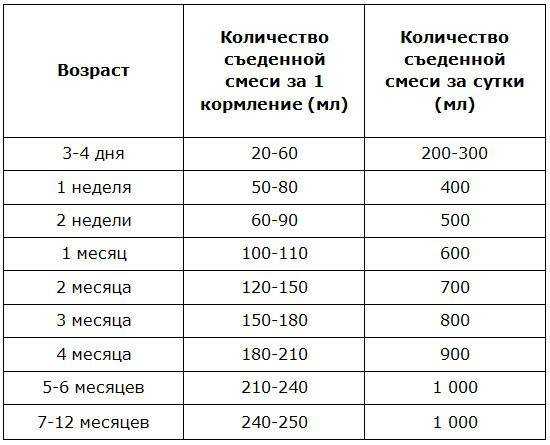
Since the table contains several parameters, we will consider each of them in more detail.
- Age
Despite the fact that our task is to feed a newborn with formula (who, by definition, should be from 0 to 1 month), the table also shows data for a later age. This way, parents will be able to compare indicators and focus on them in the future, as the baby grows up.
- Amount of formula per 1 feeding
These indicators have a fairly wide range of scope, as can be seen from the numbers already on the first line. So how much mixture should you give? 20 ml or 60? This indicator will depend on what schedule the mother will feed the newborn. If 7 times, according to the recommendations of pediatricians, then the number will be the same. If according to the first requirement (the so-called free artificial feeding), the number of meals will be greater, and the dose will be less.
- Amount of mixture per day
There is no longer such a wide range here. And if the numbers from the second column are easily adjusted depending on how often you feed your newborn with formula, then in the end you should still get the numbers from the third column - focus on them.
Although they also depend on the weight and health status of the newborn. If he is premature or has some pathology, he will not eat much in any case. But if a hero with remarkable health and large weight is born, he will, accordingly, need more mixture. But this difference is taken into account in another, more convenient, from the point of view of many parents, table.
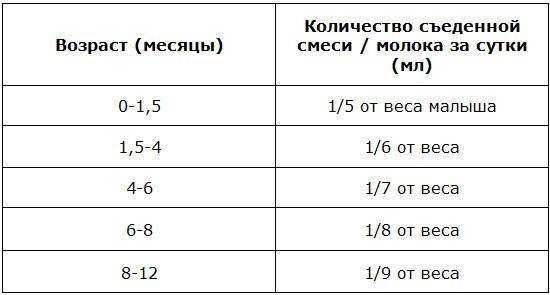
There are different ways to calculate how much formula you should feed your newborn based on his or her individual characteristics (particularly weight). You can use these formulas. They will give more accurate figures. Once you decide on the volume of food, you will need to create a feeding schedule.
Helpful advice. Most often, all these tables and formulas turn out to be unnecessary for parents for one simple reason. Most artificial formulas for newborns contain detailed instructions on how much powder to dilute in what amount of water at a time. Some manufacturers contain this information on the box, while others have it directly on the measuring bottle that is included in the mixtures.
Schedule

Decide right away how you will feed your newborn with formula - on time or on demand.
In the first case, a specific schedule will be developed that will organically fit into the daily routine. This is convenient, will allow the mother to do household chores at intervals, and will teach the baby and his stomach to be in order.
On the other hand, many pediatricians say that it is much healthier to feed the baby at his first request, in accordance with the natural urges of his body. However, there is a risk of overfeeding and further obesity.
Parents need to solve this dilemma on their own or by listening to the opinion of the local pediatrician. If you select the hourly schedule option, you can use the following table.
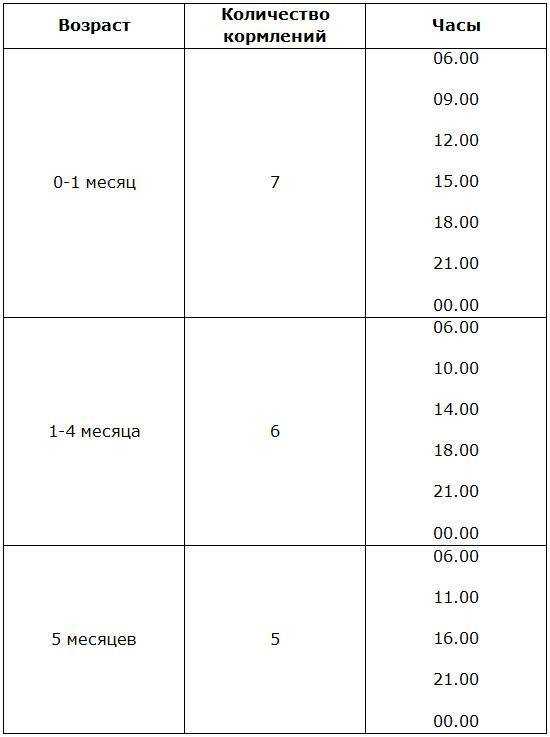
This is an approximate schedule for artificial feeding of a newborn by the hour, which can be adjusted at your discretion, taking into account the daily routine and the individual characteristics of each family separately.
Ages from 1 to 5 months are given for comparison and for convenience: after all, then it will be quite easy to stretch the intervals between meals if you immediately teach the child to eat on time, and not on demand. So choose a scheme and it’s time to learn how to prepare the mixture correctly.
You need to know this. Today, the World Health Organization (one of the most competent bodies in medicine and pediatrics) recommends that young parents abandon a strict hourly schedule in favor of feeding on demand of the newborn.
Cooking process
The well-being of a newborn who is bottle-fed will most directly depend on how correctly the mother prepares the formula.
All such products are accompanied by detailed instructions, which must be carefully studied, and all its points must be strictly followed. Among them, several general points can be distinguished.
- To dilute the dry mixture, use bottled water, which does not need to be boiled in order to preserve all its beneficial properties.
- Tap water must be boiled.
- Follow the dosage specified in the instructions for the mixture exactly. Too much powder and not enough water will cause colic and dyspeptic disorders. Too little dry base and too much water is a guarantee that the newborn will be capricious and ask to eat at the wrong time.
- Dilute the mixture immediately in the bottle.
- First, water is poured in, preheated to 50°C. If its temperature is higher than this indicator, it will destroy the beneficial bacteria of the mixture.
- After pouring the powder into the bottle, shake it well so that there are no lumps.
- Before feeding your newborn, check the temperature of the formula again: it should not exceed 37°C.
- The width of the hole in the nipple should force the newborn to make some effort to strain the mixture from the bottle.
The process of preparing the mixture is one of the main stages of feeding. The correctness of its implementation will determine how satisfied the baby will be with the food, whether he will be fully satisfied, as well as his health and further physical development.
Once you have mastered the basics of cooking for these babies, you will have to take small “courses” to learn how to feed them correctly.
Lifehack. To determine the temperature of the finished formula for a newborn, drop a little milk liquid from the bottle onto your wrist. If the skin does not feel anything, you can feed your hero. If she feels a hot or cold touch, the food will have to be cooled or heated.
Feeding process
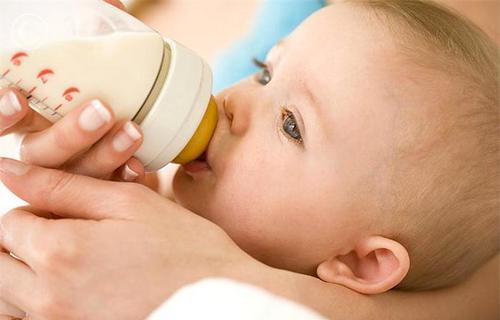
A very important point for all young mothers is to learn how to properly feed a newborn with formula, because the technique of this process is significantly different from that used for infants.
The faster you master it, the fewer problems with nutrition and further development will arise. A few useful tips will help you do this.
Newborn position
- It should not lie on its back, as the mixture will flow out of the bottle itself. Because of this, the child may choke or choke. The sucking reflex will also be formed incorrectly.
- The head should be located slightly above the body, on the bend of the mother’s arm bent at the elbow.
- The head and spine of a newborn should form a straight line.
- The baby's position during formula feeding should be the same as when breastfeeding.
Feeding technique
- A newborn should not be allowed to grasp the entire pacifier with his lips. Correct position: only the oblong part should be in his mouth, but the lips should lie on the round part.
- Make sure that the oblong part of the nipple is constantly filled with the mixture. This way, the newborn will not swallow air and then suffer from colic.
- Don't rush your baby while you feed. He himself knows the pace at which he is comfortable sucking. Don't shake the bottle, don't yell at him, and try not to show your impatience yourself.
- If your newborn refuses to eat, do not force him to eat every last drop. If the dose is less than usual, take a closer look: he may not be feeling well. In this case, consult your pediatrician.
- After feeding, pat your baby lightly on the back - this will make him burp the air he swallowed while sucking.
Breaks
- Do you want to learn how to properly feed your baby formula? Then you should take short breaks directly while eating.
- The fact is that when sucking, the baby still swallows air, which creates a false feeling of satiety. To get rid of it, you need small stops. They allow the newborn to burp, that is, to free himself from air, and again feel that he is not yet full.
- As soon as the baby moves away from the bottle, hold him in a semi-vertical or vertical position in a column and wait for the burp.
- For the same purpose, you can put it with its tummy on your shoulder, and its arms on your back.
- Another way to get rid of swallowed air is a light massage of the back, gentle pats on the butt.
- If you put him on your knees with his tummy down, the result will be the same.
- Practice different methods and choose the technique that will allow you to quickly achieve the desired effect.
- At the same time, do not forget to protect your and his clothes from regurgitation.
- If you don’t take a break and wait for regurgitation, swallowed air will cause colic and gas.
Mother and baby bond
- Very often, women who do not breastfeed their babies feel guilty, since it is believed that babies have a much closer emotional connection with their mothers. However, even with artificial animals, it can be established just during the feeding process.
- Hold your baby gently while eating.
- Talk to him: call him affectionate names, try to convey all your love and tenderness through your voice.
- Stroke your newborn while feeding - this will create close physical contact, which artificial babies so lack.
- One of the advantages of feeding with formula is the interaction of the newborn with other relatives, in particular with the dad, who can also feed him with formula from a bottle. However, in order to establish an emotional connection with the mother, it is she who must feed the baby during the first month of life.
This is the technique for feeding newborns with formula. If you learn to do it correctly, this will allow you to avoid many unpleasant moments that are considered disadvantages of artificial nutrition.
Adapted food is as close as possible in composition to breast milk. Emotional connection and close bodily contact can also be achieved. So there shouldn't be any problems. To top it off, a few more useful tips will help dispel any last doubts.
A small nuance. During a break in the middle of formula feeding, when you help the baby burp up swallowed air, you should not put him on your lap with his tummy down, although this method exists and is used in practice. Yes, the air will escape, but the pressure exerted in this position on the baby’s digestive tract can cause disruption in its functioning.
What to do if a newborn baby chokes on milk while feeding from a bottle
Many parents are confused and don’t know what to do if their newborn chokes on milk. There are several main reasons why a baby chokes when feeding. It is very important to identify the specific problem in order to eliminate similar cases in the future. In the vast majority of cases, this is due to the fact that too much milk comes out, which is why the baby chokes when breastfeeding.
Every mother may encounter this problem not only when breastfeeding, but also when the baby chokes when feeding from a bottle. Possible reasons are:
- the baby feels very hungry;
- too much milk pressure;
- incorrectly chosen feeding position.
When the baby gets hungry, he begins to suck the milk vigorously and does not have time to swallow it completely. This causes the child to choke on milk.
If a woman often needs to restrain the flow of milk due to weak nipples, then you can try feeding the baby in a sitting or reclining position. In this case, the excess milk will simply spill out. After some time, you can return to feeding in an upright position.
When the mother has too much milk, which flows in a stream even with a light touch, the baby gags when breastfeeding. At such moments, you should remove the baby from the breast and drain excess milk onto the diaper.
Another way to avoid a baby choking while breastfeeding is to rub the nipples with a small piece of ice immediately before feeding the baby. Then the milk will not flow so abundantly.
It is better to feed the baby with one breast at feeding time, and express milk from the second. Over time, the number of breastfeedings should be reduced, adhering to a certain diet.
What to do if your baby chokes
If a baby is choking when feeding from a bottle or breastfeeding, the natural defense reaction will be to cough. It very rarely happens that children cannot cough and independently push milk or other objects out of the trachea.
If a child is choking and is not breathing, urgent assistance from doctors is needed, and before they arrive, the baby should be given artificial respiration and chest compressions.
Signs that a child is choking:
- The baby cannot cope with the cough on his own.
- He begins to choke.
- He turns away from his chest and cries.
- The baby's breathing becomes noisy.
In this case, you need to call specialists, and as first aid you need to turn the baby over and put him on your outstretched leg or arm, lightly patting or pressing between the shoulder blades so that the liquid flows out of the lungs. If the baby is still an infant, pressing with two fingers is enough. If the child is already older, then you need to pat with your whole palm. This must be done until a doctor arrives or the fluid comes out.
Rate the material:
thank you, your vote has been accepted
Get to know yourself
detstrana.ru
Rules

By following all the above tips, you can quickly learn how to properly feed a newborn with formula from a bottle. If you have any doubts, you can always consult your doctor or look at the list of general recommendations.
- Do not leave your newborn alone with a bottle.
- Change the nipple periodically as it becomes deformed and worn out.
- Keep an eye on the expiration date of the mixture.
- Do not feed your baby when he is depressed or irritated. First you need to relax and calm down. Newborns sense their mother’s mood very subtly. If you are tense, the baby will also be worried.
- Do not feed your baby if he is screaming or crying to prevent him from choking. Try to calm him down first.
- Keep in mind that formula is harder and longer for your baby's stomach to digest than breast milk. Therefore, the intervals between feedings should be at least 3 hours.
- The bottle and nipple are disinfected for each meal.
- Do not leave the mixture uneaten until next time.
All these nuances of how to feed a newborn with formula are very important for his further development and health. If you do everything according to the recommendations of specialists, based on individual consultations with a pediatrician, no problems will arise.
You don’t even have to worry that your baby is deprived of breast milk. Modern baby food is adapted to the developing gastrointestinal tract of a small organism and contains a large amount of useful and nutrients necessary for normal development. Feed your child correctly with high-quality, carefully selected mixtures - and he will delight you with his good health and irrepressible energy.
www.vse-pro-detey.ru
Of course, breast milk is the best thing a mother can give to a newborn baby. But nowadays there are many objective reasons why a mother cannot breastfeed. And then the question arises about using a bottle. By and large, it doesn’t matter what’s in it, it’s important to know how to properly feed a newborn baby with formula or mother’s milk from a bottle. Remember that bottle feeding doesn't make you a bad mom and has benefits. After all, anyone can feed a baby from a bottle: dad, grandma, and even grandpa.
Why does a baby gag while bottle feeding?
There is probably not a single infant who does not choke during feeding. Some choke very rarely, others often, but it still happens.
Some mothers do not pay attention to such incidents and continue to feed as soon as the baby clears his throat, others panic, and still others try to understand the essence of the problem itself. So that this doesn't happen again in the future.
So today we will do this, we will figure out why children choke on milk and what should or should not be done to avoid this.
For convenience, I decided to list for you all the possible reasons why a child chokes on milk and immediately give recommendations for eliminating these reasons.
The baby is distracted while feeding. You probably yourself sometimes choked when, during a meal, you were told some important information or played loud music. They quickly entered the room.
The same thing can happen to a baby. If, besides the mother, there is someone else in the room and, on top of everything else, speaks loudly and tries to wink at the baby, then nothing good will come of it.
Firstly, the baby will constantly pull away from the breast, and secondly, he may choke.
If you have had such cases, then during feeding you should retire to a separate room with your baby and not use any gadgets or other equipment until the baby has eaten. If there is no opportunity for privacy, then explain to relatives that there is no need to distract the child while he is eating.
The baby grabs the milk too quickly. This usually happens because he is hungry and is trying to eat quickly. In this case, in addition to the fact that the child is choking, he also catches air and then has belching, hiccups, and colic.
If this is your case, then perhaps you should reconsider the schedule on which you feed your baby or even start feeding on demand.
The baby has a stuffy nose. Perhaps it is difficult for him to breathe through his nose and he tries to do it with his mouth and eat at the same time. Naturally, he doesn’t do this well and he begins to choke and choke. The cause of this phenomenon can be either a cold or a physiological one. "Physiological runny nose in an infant."
In this case, before feeding, it is necessary to rinse the baby’s nose with a solution of sea water or any other product prescribed by your pediatrician. It is also necessary to draw out mucus from the nose using a special tube. If you have a physiological runny nose, it is not recommended to pull out the mucus yourself, but if the child cannot eat normally because of this, then you will have to do it.
The mother has too much milk and it is already flowing. The child simply does not have time to swallow everything and begins to choke.
In such cases, it can be recommended to express a little milk before feeding, and then just start feeding.
You can try feeding your baby with only one breast and expressing the other. In this way, you will ensure that the amount of milk secreted gradually decreases and the baby stops choking.
The mother has “weak nipples.” In this case, a normal amount of milk is released, but it is not retained in the breast, but simply flows. The baby does nothing to keep the milk flowing and choke because the flow does not stop.
In this case, you can slightly restrain the flow of milk with your hand by pressing on the breast. In principle, no one is stopping you from pouring milk into a bottle and trying to feed from it.
The baby sucks milk, but has not yet fully learned to swallow. This happens to very young children in the first month of life.
There is no need to do anything here, the child will adapt to the environment and will begin to swallow milk normally.
If you are not breastfeeding, but bottle-feeding , then try changing your nipple. This may be the reason why your baby cannot eat normally.
Uncomfortable or incorrectly chosen position for feeding.
Experiment, try feeding your baby at an angle of 45 degrees to the horizontal. You don't need it to lie vertically.
If you have tried everything I wrote in this article and have not been able to identify the reason why your baby is choking on milk during feeding, then consult a doctor. The problem may lie much deeper; there may be problems with the esophagus or other digestive organs. However, this happens extremely rarely.
- If the child is choking, there is no need to continue feeding him.
- You also don't want him to continue to lie on your back; pick up your baby immediately.
- If you raised your baby vertically, and he continues to cough, then try turning his back to you, take him by the tummy with one hand, and lightly pat him on the back with the other.
That's it, dear friends, in this article I have described to you in detail all the reasons why a child chokes while eating. I hope that you will take all the information into account and this will happen to you extremely rarely.
Source: zdorovyemalisha.ru
What to do if a newborn baby chokes on milk while feeding from a bottle
Many parents are confused and don’t know what to do if their newborn chokes on milk. There are several main reasons why a baby chokes when feeding.
It is very important to identify the specific problem in order to eliminate similar cases in the future.
In the vast majority of cases, this is due to the fact that too much milk comes out, which is why the baby chokes when breastfeeding.
Every mother may encounter this problem not only when breastfeeding, but also when the baby chokes when feeding from a bottle. Possible reasons are:
- the baby feels very hungry;
- too much milk pressure;
- incorrectly chosen feeding position.
When the baby gets hungry, he begins to suck the milk vigorously and does not have time to swallow it completely. This causes the child to choke on milk.
If a woman often needs to restrain the flow of milk due to weak nipples, then you can try feeding the baby in a sitting or reclining position. In this case, the excess milk will simply spill out. After some time, you can return to feeding in an upright position.
When the mother has too much milk, which flows in a stream even with a light touch, the baby gags when breastfeeding. At such moments, you should remove the baby from the breast and drain excess milk onto the diaper.
Another way to avoid a baby choking while breastfeeding is to rub the nipples with a small piece of ice immediately before feeding the baby. Then the milk will not flow so abundantly.
It is better to feed the baby with one breast at feeding time, and express milk from the second. Over time, the number of breastfeedings should be reduced, adhering to a certain diet.
If a baby is choking when feeding from a bottle or breastfeeding, the natural defense reaction will be to cough. It very rarely happens that children cannot cough and independently push milk or other objects out of the trachea.
If a child is choking and is not breathing, urgent assistance from doctors is needed, and before they arrive, the baby should be given artificial respiration and chest compressions.
Signs that a child is choking:
- The baby cannot cope with the cough on his own.
- He begins to choke.
- He turns away from his chest and cries.
- The baby's breathing becomes noisy.
In this case, you need to call specialists, and as first aid you need to turn the baby over and put him on your outstretched leg or arm, lightly patting or pressing between the shoulder blades so that the liquid flows out of the lungs. If the baby is still an infant, pressing with two fingers is enough. If the child is already older, then you need to pat with your whole palm. This must be done until a doctor arrives or the fluid comes out.
thank you, your vote has been accepted
Little children are happiness for every mother.
You can look at them endlessly, like fire and water.
They give us smiles, a feeling of tenderness and neediness, arouse in us a flurry of love, although motherhood is not without anxiety.
Particularly alarming for all mothers are those moments when children suddenly choke on something.
To prevent a sad outcome in such situations, you need to know exactly what to do if a child is choking.
There are countless cases when a child can choke. Firstly, when feeding. If the mother is breastfeeding, the pressure of the milk may be very strong, or the baby may suck very actively.
The very structure of the female breast and improper attachment to it can also contribute to the fact that a newborn chokes. Such situations are also possible when bottle feeding. Too large portions of the mixture arrive when a too large hole is cut in the nipple of the bottle.
Feeding a child in a horizontal position. The correct position is half-sided on the back with your head raised.
The baby may simply lose his breath and his mouth quickly fills with saliva. This happens because babies do not yet know how to control and combine the process of swallowing with the breathing process. In addition, food unusual for newborns, be it puree, porridge or mixture, gives babies new and unusual sensations.
A common case is when children put foreign objects in their mouths that are within their reach. Therefore, it is necessary to strictly ensure that small parts of toys, rattles, lids, and so on are not located near the child.
What to do if a newborn chokes when regurgitating
The most common sign that a child is choking is a cough. If the baby is actively coughing after choking, it means that the airways are clear and nothing threatens them. In this case, mother's help is not required. The most important thing is to prevent liquid, food or foreign objects from blocking the airways and causing suffocation or asphyxia.
It is much more dangerous when a child chokes on something and cannot get rid of it on his own.
The fact that urgent and emergency help is required can be signaled by such signs as: a blue tint to the child’s skin, wide open eyes, fear in them, increased salivation, an open mouth, the baby cannot cough and cry, and constantly reaches for the neck with his hands.
Source: https://skystream.org/o-detyah/pochemu-rebenok-davitsya-vo-vremya-kormleniya-iz-butylochki/
How and when to feed your baby
As with breastfeeding, a baby using artificial formula is also fed on demand. This will make it possible to prevent the child from worrying due to hunger. The norms for formula consumption by age and the number of recommended feedings are usually written on cans of infant formula. Do not be upset if the baby does not cope with the prescribed norm at one time; next time he will require feeding earlier. Bottle feeding is as intimate and touching a moment as breastfeeding. Both baby and mother should be calm.
The mother's task is to provide the baby with pleasant physical rest and eye contact during feeding.
Reasons and recommendations
For convenience, I decided to list for you all the possible reasons why a child chokes on milk and immediately give recommendations for eliminating these reasons.
The baby is distracted while feeding. You probably yourself sometimes choked when, during a meal, you were told some important information or played loud music. They quickly entered the room. The same thing can happen to a baby. If, besides the mother, there is someone else in the room and, on top of everything else, speaks loudly and tries to wink at the baby, then nothing good will come of it. Firstly, the baby will constantly pull away from the breast, and secondly, he may choke.
If you have had such cases, then during feeding you should retire to a separate room with your baby and not use any gadgets or other equipment until the baby has eaten. If there is no opportunity for privacy, then explain to relatives that there is no need to distract the child while he is eating.
The baby grabs the milk too quickly. This usually happens because he is hungry and is trying to eat quickly. In this case, in addition to the fact that the child is choking, he also catches air and then has belching, hiccups, and colic.
If this is your case, then perhaps you should reconsider the schedule on which you feed your baby or even start feeding on demand.
The baby has a stuffy nose. Perhaps it is difficult for him to breathe through his nose and he tries to do it with his mouth and eat at the same time. Naturally, he doesn’t do this well and he begins to choke and choke. The cause of this phenomenon can be either a cold or a physiological one. "Physiological runny nose in an infant."
Preparing to Bottle Feed
Before you bottle feed your baby, you need to purchase a bottle and a pacifier for it. When choosing a bottle it is important:
- the material from which the bottle is made (it can be glass or plastic - glass is more durable, and plastic is lighter and more convenient);
- There must be divisions on the bottle to determine the amount eaten.
Buy several bottles , then you can use different bottles for water and mixture; for home and walking. The purchased bottle must be thoroughly washed and sterilized. Nipples are usually sold complete with bottles and have age recommendations (depending on the age, the baby sucks faster or slower, respectively, the hole will be larger or smaller). If the hole is chosen correctly, the baby will eat the prescribed amount in 15-20 minutes. The pacifier is also washed and sterilized.
When selecting a mixture, the pediatrician is your main assistant and advisor. He will help you choose the mixture that best suits the baby’s physiological characteristics, as well as the one that best suits the baby’s age.
Check the temperature of the formula before feeding . Usually a little of the mixture is dripped onto the wrist. If the droplet is neither hot nor cold, you can start feeding.
The process of bottle feeding a newborn baby
Mom needs to remove her hair, put on clean clothes for feeding and make herself more comfortable. The baby should not be placed on its back. He might choke. It is better to place him on your lap, so that the baby's head is slightly higher than body level.
The baby's position should be natural and resemble the position during breastfeeding. The baby's head should not be turned to one side. He will have difficulty swallowing. To keep the entire feeding process under control, the mother must establish eye contact with the baby.
It is recommended to keep the bottle itself horizontally under a small cover. This is necessary to prevent milk from filling the entire nipple. It is important to ensure that no air gets into the nipple and that it is constantly filled with mixture. When the baby swallows air, colic begins.
It is better if the baby touches the mother’s skin during feeding , then he will be calmer and the mother will be more confident. After all, she will not have a feeling of guilt for the fact that she cannot feed her baby with breast milk. Do not place dishes with formula on the baby, propping it up with something. This is very dangerous, as the baby may choke.
The baby drinks the mixture quite quickly, in five to ten minutes. It flows out steadily and the pacifier is not difficult to suck. If the baby makes sounds like he is choking, there is probably a large hole in the nipple and it should be replaced with a smaller one. When the baby is satisfied after drinking the mixture, he should be placed in a column, pressed against his own shoulder. This is necessary so that the baby burps the air that he swallowed during feeding.
As for timing, the feeding process may vary depending on the baby's temperament. If he is hungry, he will eat actively . But if the baby has a calm temperament and takes short breaks between sucking, then the feeding time may increase. If the baby falls asleep with a bottle in his mouth, it should be carefully removed so that the child does not choke in his sleep.
During the feeding process, children sometimes take short breaks to feel if there is a feeling of hunger. Important! The mother feeds the baby correctly if bubbles form in the bottle. When they are gone, and the nipple has already stuck together from active sucking, you should carefully remove it from your mouth. If the child clings to the bottle and does not want to give it up, you need to slowly place a clean finger between the baby’s lips. This is necessary to ensure that air gets into the dishes.
Features of feeding
So, the bottle and nipple have been purchased and sterilized, the formula has been prepared, let’s find out how to properly hold the bottle when feeding a newborn. The bottle should be held at an angle of 45°, while constantly checking that the nipple is filled with the mixture. This position of the bottle prevents excess air from entering the baby's tummy. When air gets in, it creates a false feeling of fullness; in addition, it causes bloating and colic. To avoid this, hold your baby after column feeding. In this position, excess air will be burped.
Bottle feeding technique
- Press the pacifier to the baby's lower lip - he will open his mouth slightly and begin to suck. If the baby does not open his mouth, move the pacifier over the baby's lips. When the baby begins to suck, make sure that his tongue is under the nipple and his lips are wrapped around the wide part of the nipple.
- Each baby suckles at his own pace. Don't try to influence this process. In addition to satiation during feeding, the newborn also satisfies its need for sucking.
- Make sure that the hole in the nipple is optimal. You'll know something is wrong if your baby starts to choke or gets tired quickly when feeding.
- It is considered normal if 10-20 grams of the mixture remain uneaten.
- After feeding, allow your baby to burp up any excess air.
- Pat your baby on the back while feeding and make eye contact with him. This is a pleasant feeling not only for the baby, but also for you.
The child chokes while feeding: what to do?
A newborn chokes when feeding for various reasons. Some of them the mother can eliminate, while others depend on the baby’s health. Pediatrician Anastasia Anatolyevna Nikulina will explain the causes and solutions to this problem.
— Anastasia Anatolyevna, at what age do children most often choke when feeding?
— In the first weeks of life, when the swallowing reflex is still very weak, it is difficult to dose the supply of milk from the breast. From the bottle, the flow of milk formula is controlled using the hole in the nipple and the tilt. If the hole in the nipple does not correspond to its age, it is tight, then the newborn swallows air. Excess air with the mixture will enter the intestines, causing discomfort in the baby.

Why does a baby choke when breastfeeding or bottle feeding?
- Poor baby position or bottle angle. In an optimal position. In the desired position, the hand of the woman holding the child lies on the support. Hold the baby by the back and shoulders, directing the head to the chest. You can’t put too much pressure on the head - the baby will tilt it back reflexively.
- Anatomical features of the mother's breast, in which the woman produces enough breast milk, but it is difficult for the child to suck it and eat it. Before feeding, the mother needs to express some of the milk or massage the breasts: it will become soft and it will be easier for the baby to suck.
- Large nipples are difficult for a child to grasp; to solve the problem, there are special nipple covers through which newborns are fed. You can feed your baby expressed milk through a bottle and an age-appropriate pacifier.
- Hyperlactation. Breast milk flows under pressure into the baby's mouth. Before feeding, part of the foremilk is expressed, and the next, fatter one, does not form a strong flow. Taking breaks during the sucking process also helps.
- Frequent breastfeeding. The absence of long breaks between breastfeeding prevents child hunger and, along with it, rush during feeding.
- Incorrect bottle delivery method. The neck of the bottle must be completely filled with milk: this way there will be no air in the milk. The pacifier is selected taking into account the baby's age.
- Disease. Poor nasal breathing or coughing interferes with feeding. Relieving the symptoms of the disease will improve nutrition. In some children, problems may be caused by poor swallowing or reflux.
- To understand why your baby is having difficulty swallowing, you need to gradually eliminate each of the possible causes. Even the environment matters. During feeding hours, it is advisable for a woman to be alone with her child; nothing should distract him from the process. If a mother finds it difficult to identify the cause, a pediatrician will help her.
— What to do if a child chokes on milk or formula?
— A spontaneously occurring cough is the main symptom that appears when the act of sucking and swallowing is disturbed. The baby cries and refuses to eat.

First aid for choking children
If you can’t cough up excess milk on your own or the baby chokes on saliva and begins to choke, you need to do the following, dosing the strength of your actions:
- Place the baby on one arm, belly down, with your free hand apply pressure on the area above the navel (on the area of the baby's stomach), supporting the chin.
- Lean the child forward a little and lightly pat the back. This will make your cough worse and help restore your breathing.
— Is it possible to continue feeding after the child has coughed, or should I take a break?
- Feeding can be continued after the baby has cleared his throat. It is advisable to carry it in a column for two to three minutes to allow excess air to escape, and then resume feeding.
— Does increasing the intervals between feedings help cope with the problem?
- On the contrary, frequent feeding will be the prevention of choking. With numerous latches, less milk accumulates in a woman’s breasts, making it easier for the mother to feed.
If the child chokes, feeding must be interrupted. The baby will clear his throat, rest and continue to suck. If the situation occurs frequently, be sure to consult your pediatrician. Your doctor will help you find the best breastfeeding or formula-feeding option that suits your situation.
Pediatrician Anastasia Anatolyevna Nikulina
*The ideal food for an infant is mother's milk. WHO recommends exclusive breastfeeding for the first 6 months. MAMAKO® supports this recommendation. Before introducing new foods into your baby’s diet, consult a specialist.
Baby's position
For feeding to go well, not only formula, bottles and nipples are important, but also the position in which you will bottle feed your newborn. First, make yourself comfortable. May you have good support for your back and legs. Position your baby on your lap so that his head is slightly higher than his body. To do this, bend your arm (usually your left) at the elbow and place the baby’s head in the fold, while making sure that the spine and head are on the same line, without kinks. That is, the position of the baby will be the same as during breastfeeding. Important! Never feed your baby in a horizontal position. He might choke!
What to do after feeding
When the parents have finished feeding the newborn, he needs to be allowed to burp the air that accidentally entered the intestines. If this does not happen, then colic and increased gas formation will begin to bother him and cause discomfort. Swallowing air also gives an erroneous feeling of fullness. The baby is lifted up in a column and stroked on the back. The child is carried in an upright position for several minutes until a burp appears.
Then you need to put the children's dishes in order. It is washed in warm water using a brush. You can sterilize bottles and nipples in advance, but this is not necessary. The remains of the formula should not be saved and offered to the baby for the next feeding, as bacteria that have settled in it can cause poisoning. The baby should always be given only freshly prepared formula
. When breastfeeding together, supplementary feeding is given only after breastfeeding.
Breaks during feeding
No matter how hard you try to avoid air getting in during feeding, it's likely that some will get in.
If your baby has eaten very little and is restless, put the bottle aside and stand the baby in a “column” so that he can burp air. You can place the baby on your shoulder , holding his head and placing his arms on your back. In this case, you can lightly tap on the back. To avoid staining your clothes, place your baby's bib or towel over your shoulder.
How to properly bottle feed a newborn - video
Watch this short video to learn how to bottle feed your baby correctly. From it you will learn which nipple best imitates the mother's breast, and how quickly the mixture should flow. See your baby's optimal position and get tips on bottle feeding. There is nothing better than breast milk for a newborn baby. However, if for some reason you were unable to establish breastfeeding, you can use formula and raise a healthy and happy child.
Write in the comments which bottles suited your baby best? What mixtures and for what physiological characteristics of the baby do you consider the best?
www.beremennost-po-nedeliam.com
What to do if your baby is choking
- If the child is choking, there is no need to continue feeding him.
- You also don't want him to continue to lie on your back; pick up your baby immediately.
- If you raised your baby vertically, and he continues to cough, then try turning his back to you, take him by the tummy with one hand, and lightly pat him on the back with the other.
That's it, dear friends, in this article I have described to you in detail all the reasons why a child chokes while eating. I hope that you will take all the information into account and this will happen to you extremely rarely.
It's scary to watch your baby choke and struggle to breathe while bottle feeding. This often happens because their airways are so small, or perhaps because of an underlying medical condition such as a swallowing disorder or developmental delay. If your baby is susceptible to this problem, it's time to go back to basics and make sure you're feeding him properly. No specialized nipples or expensive bottles are required to help keep your baby from choking and feeding correctly.


